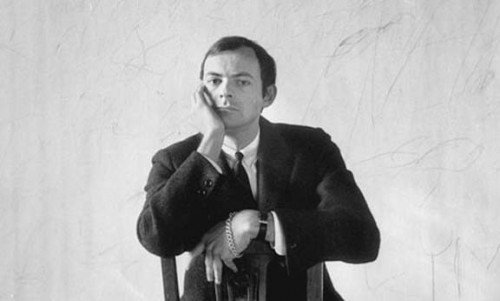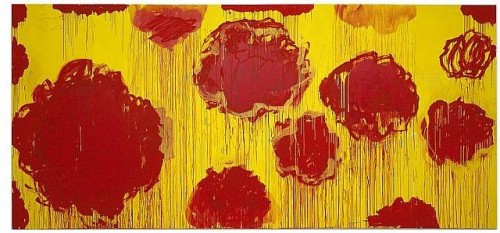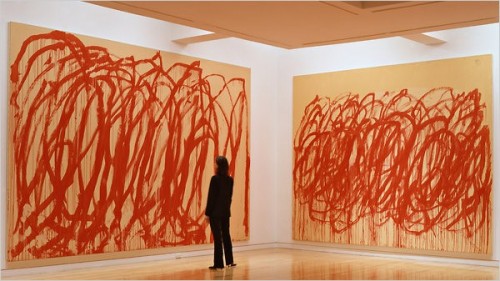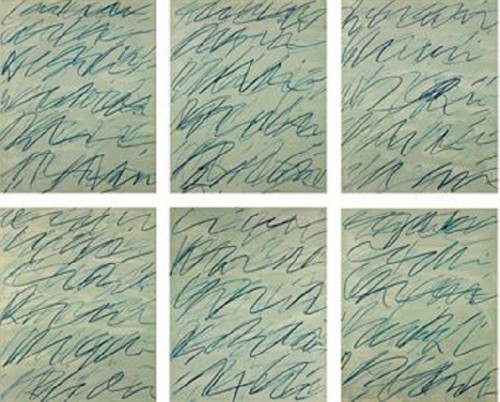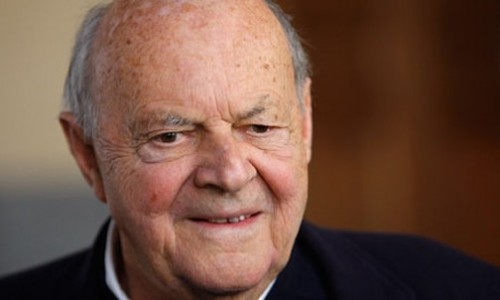Cy Twombly Dies In Rome
Creator of A Unique Elusive Aesthetic
By: Mark Favermann - Jul 12, 2011
Artist Cy Twombly died in Rome last week. Though I never met him, I was somehow connected to him. Twombly grew up in the small Shenandoah Valley town of Lexington, Virginia. He and I went to college there as well. He went for only one year in the early 50s, and I went for four in the late 60s.
It was a coat and tie all male school during that time. Twombly attended the Boston Museum School for a year previously. Later, for a short time, he attended Black Mountain College.
Washington & Lee University is a small preppy liberal arts college that once was presided over by General Robert E. Lee for five years after the Civil War (until he died). Lee and the bones of his horse Traveler are buried on the grounds of the old college.
A primitive sculpture of George Washington resides in white atop of the oldest building complex, The Colonnade. But from a distance Ol' George looks all right. Maybe this art by a handyman is a metaphor?
Twombly’s father was the athletic director and swimming coach for the college for many years. He had retired by the time that I matriculated, but I saw his rather rumpled body and quite lived in face amble along on the hilly campus.
W&L had a tradition of greeting everyone that passed, so I probably said hello to Coach Twombly scores of times. I never was formally introduced to him however. The college’s swimming pool is named the Twombly Pool.
I mention all this because the bucolic setting of the beautiful Blue Ridge Mountains must have impacted or even imprinted upon the artist. Far from figurative, there was always a moodiness to the work of Twombly, a visual gesture punctuated by the suggestion of vague image, a rough approximation of form, squiggles of line and sometimes even words.
His work, though almost from the beginning was considered of major importance, is hard to categorize. It swirled, scribbled and was both soft and loudly visual. Some of his paintings are secret writings while others are complex exercises in either line, erasures, blotches or smudges. It is an art of heroic gestures.
The changing seasons, the moving clouds, the weather patterns and the abstracted shapes of the mountains and valleys of his hometown apparently touched Cy Twombly’s creative soul. Cy Twombly’s work defies easy aesthetic interpretations.
In recent years, his work has brought millions at auction. In 2002, an untitled Twombly painting set an auction record for the artist at Sotheby's, fetching $5.6 million. Before that, a 1990 Christie's auction set a record for Twombly, with his 1971 untitled blackboard painting for $5.5 million.
He was honored throughout the world. One of his last was in 2010. Twombly was commissioned to paint a ceiling of the Louvre Museum in Paris. He was the first artist given the honor since Georges Braque in the 1950s.
Art historians usually lump him together with his close friends Robert Rauschenberg and Jasper Johns. Though each of their individual work is quite distinctively different, in time period their work followed the Abstract Expressionists. Of the three, Twombly’s work is the most abstract and perhaps the most cerebral.
The New York Times and various other obituaries got it wrong: Twombly did not just live in Italy since 1957, but also lived in Lexington, Virginia during much of the Spring and Summer months in the last couple of decades. In fact, he was something of a fixture in the town and on the university campus.
In his later years, he was avuncular in appearance. He would sometimes drop in on professors and occasionally on classes. Very well read (his paintings were often referenced to classic mythology and literature), he once assisted a philosophy professor with a class, but soon stopped as he did not want to be tied down.
His studio was behind a storefront on Lexington’s Main Street. His works were his passion.
Another world class artist resides in Lexington, the photographer Sally Mann. She was born in 1951 the year Cy Twombly left Lexington the second time. Her father was the town general practitioner, and her mother ran the W&L bookstore when I was a student there. I remember a teenage Sally as a quite beautiful barefoot flower child walking around the campus. She and her husband raised their children on a farm outside Lexington.
Sally and Cy became friends when Twombly moved back to Lexington. They were far different as artists but somehow the small town, beautifully elegant campus, the mountains, the wildlife and the general natural beauty of the area had deep meaning to their particular work. Perhaps it was just in the mountain valley air?
The Town of Lexington, Virginia and the Washington & Lee University campus environment somehow assisted in producing two world class artists. Mann deals with the figure as it degenerates, gets lost or becomes ghosted by the environment; Twombly dealt with the essential essence of the environment, its gestural referencing and its delicate abstraction.
Twombly’s work not only defied clear definition but transcended artistic styles and fads. Cy Twombly’s aesthetic was unique. To some artists and curators he is inspirational; to others he is an enigma. Perhaps that sums up Cy Twombly: an inspirational enigma. He was 83.

